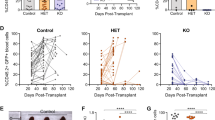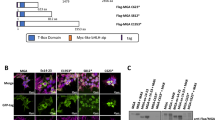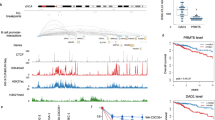Abstract
Approximately 25% of childhood B-cell precursor acute lymphoblastic leukemia have an ETV6/RUNX1 (E/R) gene fusion that results from a t(12;21). This genetic subgroup of leukemia is associated with near-triploidy, near-tetraploidy, and trisomy 21 as rather specific types of secondary changes. Here, we show that, unlike various controls, E/R-expressing Ba/F3 clones acquire a tetraploid karyotype on prolonged culture, corroborating the assumption that E/R may attenuate the mitotic checkpoint (MC). Consistent with this notion, E/R-expressing diploid murine and human cell lines have decreased proportions of cells with 4N DNA content and a lower mitotic index when treated with spindle toxins. Moreover, both RUNX1 and E/R regulate mitotic arrest-deficient 2 L1 (MAD2L1), an essential MC component, by binding to promoter-inherent RUNX1 sites, which results in down-regulation of MAD2L1 mRNA and protein in E/R-expressing cells. Forced expression of E/R also abolishes RUNX1-induced reporter activation, whereas E/R with a mutant DNA-binding site leads to only minor effects. Our data link for the first time E/R, MC, and MAD2L1 and provide new insights into the function of the E/R fusion gene product. Although tetraploidy is an almost exclusive feature of E/R-positive leukemias, its rarity within this particular subgroup implies that further yet unknown factors are required for its manifestation.
This is a preview of subscription content, access via your institution
Access options
Subscribe to this journal
Receive 50 print issues and online access
$259.00 per year
only $5.18 per issue
Buy this article
- Purchase on Springer Link
- Instant access to full article PDF
Prices may be subject to local taxes which are calculated during checkout




Similar content being viewed by others
References
Attarbaschi A, Mann G, Konig M, Dworzak MN, Trebo MM, Muhlegger N et al. (2004). Incidence and relevance of secondary chromosome abnormalities in childhood TEL/AML1+ acute lymphoblastic leukemia: an interphase FISH analysis. Leukemia 18: 1611–1616.
Attarbaschi A, Mann G, Konig M, Steiner M, Dworzak MN, Gadner H et al. (2006). Near-tetraploidy in childhood B-cell precursor acute lymphoblastic leukemia is a highly specific feature of ETV6/RUNX1-positive leukemic cases. Genes Chromosomes Cancer 45: 608–611.
Boyapati A, Yan M, Peterson LF, Biggs JR, Le Beau MM, Zhang DE . (2007). A leukemia fusion protein attenuates the spindle checkpoint and promotes aneuploidy. Blood 109: 3963–3971.
Diakos C, Krapf G, Gerner C, Inthal A, Lemberger C, Ban J et al. (2007). RNAi-mediated silencing of TEL/AML1 reveals a heat-shock protein- and survivin-dependent mechanism for survival. Blood 109: 2607–2610.
Fang Y, Liu T, Wang X, Yang YM, Deng H, Kunicki J et al. (2006). BubR1 is involved in regulation of DNA damage responses. Oncogene 25: 3598–3605.
Ford AM, Palmi C, Bueno C, Hong D, Cardus P, Knight D et al. (2009). The TEL-AML1 leukemia fusion gene dysregulates the TGF-beta pathway in early B lineage progenitor cells. J Clin Invest 119: 826–836.
Friedman AD . (1999). Leukemogenesis by CBF oncoproteins. Leukemia 13: 1932–1942.
Guardavaccaro D, Frescas D, Dorrello NV, Peschiaroli A, Multani AS, Cardozo T et al. (2008). Control of chromosome stability by the beta-TrCP-REST-Mad2 axis. Nature 452: 365–369.
Ha GH, Baek KH, Kim HS, Jeong SJ, Kim CM, McKeon F et al. (2007). p53 activation in response to mitotic spindle damage requires signaling via BubR1-mediated phosphorylation. Cancer Res 67: 7155–7164.
Hiebert SW, Sun W, Davis JN, Golub T, Shurtleff S, Buijs A et al. (1996). The t(12;21) translocation converts AML-1B from an activator to a repressor of transcription. Mol Cell Biol 16: 1349–1355.
Hong D, Gupta R, Ancliff P, Atzberger A, Brown J, Soneji S et al. (2008). Initiating and cancer-propagating cells in TEL-AML1-associated childhood leukemia. Science 319: 336–339.
Kops GJ, Weaver BA, Cleveland DW . (2005). On the road to cancer: aneuploidy and the mitotic checkpoint. Nat Rev Cancer 5: 773–785.
Li Z, Yan J, Matheny CJ, Corpora T, Bravo J, Warren AJ et al. (2003). Energetic contribution of residues in the Runx1 Runt domain to DNA binding. J Biol Chem 278: 33088–33096.
Lou J, Cao W, Bernardin F, Ayyanathan K, Rauscher IF, Friedman AD . (2000). Exogenous cdk4 overcomes reduced cdk4 RNA and inhibition of G1 progression in hematopoietic cells expressing a dominant-negative CBF—a model for overcoming inhibition of proliferation by CBF oncoproteins. Oncogene 19: 2695–2703.
Michel L, Benezra R, Diaz-Rodriguez E . (2004). MAD2 dependent mitotic checkpoint defects in tumorigenesis and tumor cell death: a double edged sword. Cell Cycle 3: 990–992.
Morrow M, Samanta A, Kioussis D, Brady HJ, Williams O . (2007). TEL-AML1 preleukemic activity requires the DNA binding domain of AML1 and the dimerization and corepressor binding domains of TEL. Oncogene 26: 4404–4414.
Perez de Castro I, de Carcer G, Malumbres M . (2007). A census of mitotic cancer genes: new insights into tumor cell biology and cancer therapy. Carcinogenesis 28: 899–912.
Peters JM . (2007). Cell biology: the checkpoint brake relieved. Nature 446: 868–869.
Pines J . (2006). Mitosis: a matter of getting rid of the right protein at the right time. Trends Cell Biol 16: 55–63.
Pui CH, Relling MV, Downing JR . (2004). Acute lymphoblastic leukemia. N Engl J Med 350: 1535–1548.
Raimondi SC, Zhou Y, Shurtleff SA, Rubnitz JE, Pui CH, Behm FG . (2006). Near-triploidy and near-tetraploidy in childhood acute lymphoblastic leukemia: association with B-lineage blast cells carrying the ETV6-RUNX1 fusion, T-lineage immunophenotype, and favorable outcome. Cancer Genet Cytogenet 169: 50–57.
Ross ME, Zhou X, Song G, Shurtleff SA, Girtman K, Williams WK et al. (2003). Classification of pediatric acute lymphoblastic leukemia by gene expression profiling. Blood 102: 2951–2959.
Roudaia L, Cheney MD, Manuylova E, Chen W, Morrow M, Park S et al. (2009). CBFbeta is critical for AML1-ETO and TEL-AML1 activity. Blood 113: 3070–3079.
Sasaki K, Nakamura Y, Maki K, Waga K, Nakamura F, Arai H et al. (2004). Functional analysis of a dominant-negative DeltaETS TEL/ETV6 isoform. Biochem Biophys Res Commun 317: 1128–1137.
Song WJ, Sullivan MG, Legare RD, Hutchings S, Tan X, Kufrin D et al. (1999). Haploinsufficiency of CBFA2 causes familial thrombocytopenia with propensity to develop acute myelogenous leukaemia. Nat Genet 23: 166–175.
Sotillo R, Hernando E, Diaz-Rodriguez E, Teruya-Feldstein J, Cordon-Cardo C, Lowe SW et al. (2007). Mad2 overexpression promotes aneuploidy and tumorigenesis in mice. Cancer Cell 11: 9–23.
Speck NA, Gilliland DG . (2002). Core-binding factors in haematopoiesis and leukaemia. Nat Rev Cancer 2: 502–513.
Strom DK, Nip J, Westendorf JJ, Linggi B, Lutterbach B, Downing JR et al. (2000). Expression of the AML-1 oncogene shortens the G(1) phase of the cell cycle. J Biol Chem 275: 3438–3445.
Weaver BA, Cleveland DW . (2005). Decoding the links between mitosis, cancer, and chemotherapy: the mitotic checkpoint, adaptation, and cell death. Cancer Cell 8: 7–12.
Wolyniec K, Wotton S, Kilbey A, Jenkins A, Terry A, Peters G et al. (2009). RUNX1 and its fusion oncoprotein derivative, RUNX1-ETO, induce senescence-like growth arrest independently of replicative stress. Oncogene 28: 2502–2512.
Wotton S, Terry A, Kilbey A, Jenkins A, Herzyk P, Cameron E et al. (2008). Gene array analysis reveals a common Runx transcriptional programme controlling cell adhesion and survival. Oncogene 27: 5856–5866.
Zelent A, Greaves M, Enver T . (2004). Role of the TEL-AML1 fusion gene in the molecular pathogenesis of childhood acute lymphoblastic leukaemia. Oncogene 23: 4275–4283.
Acknowledgements
We thank O Williams for expression vectors containing E/R or the mutant E/R, D-E Zhang for the RUNX1-expression vector, A Friedman for CBFβ-expression vector, D Guardavaccaro for the luciferase reporter plasmid for the MAD2L1 promoter in pGL3, JD Rowley for AT-2 cell line, L Orel for the Myc-ETV6/RUNX1 vector, Idriss M Bennani-Baiti for stimulating discussions, and Marion Zavadil for proofreading the paper. This study was supported in part by a grant from the FWF P17551-B14 and the Austrian Ministry for Education, Science and Culture (GENAU-Ch.I.L.D) and the St Anna Kinderkrebsforschung to ER P-G. A Kilbey is funded by the Leukaemia Research Fund. GK participated in the design of the study, performed experiments, interpreted data, and wrote the paper. UK, GF, AI, RJ performed research and interpreted data. AK performed and interpreted ChIP experiments. JCN participated in study design and interpretation of ChIP data. GM contributed patient samples. OAH participated in the interpretation of data and writing of the paper. ER P-G designed and supervised research and wrote the paper.
Author information
Authors and Affiliations
Corresponding author
Ethics declarations
Competing interests
The authors declare no conflict of interest.
Additional information
Supplementary Information accompanies the paper on the Oncogene website
Supplementary information
Rights and permissions
About this article
Cite this article
Krapf, G., Kaindl, U., Kilbey, A. et al. ETV6/RUNX1 abrogates mitotic checkpoint function and targets its key player MAD2L1. Oncogene 29, 3307–3312 (2010). https://doi.org/10.1038/onc.2010.53
Received:
Revised:
Accepted:
Published:
Issue Date:
DOI: https://doi.org/10.1038/onc.2010.53
Keywords
This article is cited by
-
PIGN spatiotemporally regulates the spindle assembly checkpoint proteins in leukemia transformation and progression
Scientific Reports (2021)
-
Chromosome integrity checkpoints in stem and progenitor cells: transitions upon differentiation, pathogenesis, and aging
Cellular and Molecular Life Sciences (2018)
-
Blocking ETV6/RUNX1-induced MDM2 overexpression by Nutlin-3 reactivates p53 signaling in childhood leukemia
Leukemia (2014)



